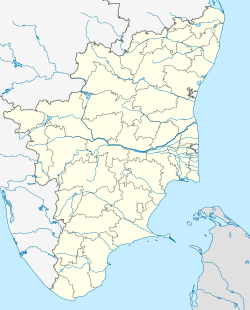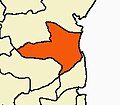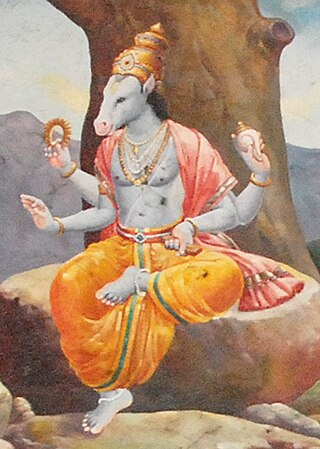
Hayagriva is a Hindu deity, the horse-headed avatar of Vishnu. The purpose of this incarnation was to slay a danava also named Hayagriva, who had the neck of a horse and the body of a human.

Cuddalore District is one of the 38 districts in the state of Tamil Nadu in India.
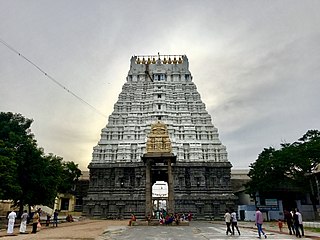
Varadharaja Perumal Temple, also called Hastagiri and Attiyuran, is a Hindu temple dedicated to Vishnu located in the city of Kanchipuram, Tamil Nadu, India. It is one of the Divya Desams, the 108 temples of Vishnu believed to have been visited by the 12 poet saints, or the Alvars. It is located in a suburb of Kanchipuram known as the Vishnu Kanchi that is a home for many famous Vishnu temples. One of the greatest Hindu scholars of Vaishnava Vishishtadvaita philosophy, Ramanuja, is believed to have resided in this temple.

Vaikhanasa or Vaikhanasagama is a tradition of Hinduism that primarily worships Vishnu as the Supreme God. The tradition draws its name from the philosophy propounded by its founder, Sage Vikhanasa.

Oppiliappan Temple, is a Hindu temple dedicated to Vishnu, located near Thirunageswaram and also known by its old toponym Thiruvinnagar, a village in the outskirts of the Kumbakonam in the South Indian state of Tamil Nadu. Constructed in the Dravidian style of architecture, the temple is glorified in the Naalayira Divya Prabandham, the early medieval Tamil canon of the Alvar saints from the 6th–9th centuries CE. It is counted as the 60th of the 108 Divya Desams dedicated to Vishnu. Vishnu is worshiped as Oppiliappan and his consort Lakshmi as Bhudevi.

The Pundarikakshan Perumal Temple or Thiruvellarai Temple in Thiruvellarai, a village in the outskirts of Tiruchirappalli in the South Indian state of Tamil Nadu, is dedicated to the Hindu god Vishnu. Constructed in the Dravidian style of architecture, the temple is glorified in the Naalayira Divya Prabandham, the early medieval Tamil canon of the Alvar saints from the 6th–9th centuries CE. It is one of the 108 Divya Desams dedicated to Vishnu, who is worshipped as Pundarikakshan and his consort Lakshmi as Pankajavalli.

The Jagad Rakshaka Perumal Temple or Thirukoodalur in Vadakurangaduthurai, a village in the outskirts of Kumbakonam in the South Indian state of Tamil Nadu, is dedicated to the Hindu god Vishnu. Constructed in the Dravidian style of architecture, the temple is glorified in the Nalayira Divya Prabandham, the early medieval Tamil canon of the Alvar saints from the 6th–9th centuries CE. It is one of the 108 Divya Desams dedicated to Vishnu, who is worshipped as Jakath Rakshaka and his consort Lakshmi as Pushpavalli.

The Adi Jagannatha Temple is a South Indian Hindu temple in Thiruppullani, a village in the outskirts of Ramanathapuram in the South Indian state of Tamil Nadu, is dedicated to the Hindu god Vishnu. It is believed that Rama used grass ('pul' in Tamil as a pillow to sleep and hence the village attained the name Thiruppullani. Constructed in the Cholan style of architecture, the temple is glorified in the Naalayira Divya Prabandham, the early medieval Tamil canon of the Alvar saints from the 6th–9th centuries CE. It is one of the 108 Divya Desam dedicated to Vishnu, who is worshipped as Adi Jagannatha and his consort Lakshmi as Padmasini.
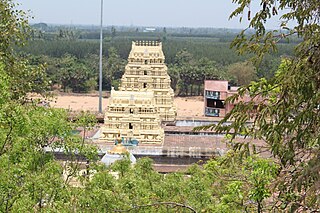
Devanatha Hemabhujavalli Temple is a Hindu temple in Thiruvanthipuram, a village in the outskirts of Cuddalore in the South Indian state of Tamil Nadu, dedicated to the god Vishnu and goddess Lakshmi. Constructed in the Dravidian style of architecture, the temple is glorified in the Nalayira Divya Prabandham, the early medieval Tamil canon of the Alvar saints from the 6th–9th centuries CE. It is one of the 108 Divya Desams dedicated to Vishnu, who is worshipped as Devanatha and Lakshmi as Hemabhujavalli. Though the presiding deity is Devanatha and Hemabhujavalli, the temple is known for Hayagriva, the ninth avatara of Vishnu in the Dashavatara of Vishnu and a god of knowledge. The temple is the only historical temple in South India to have a shrine of Hayagriva on hilltop.

The Saranathan Temple in Thirucherai, a village on the outskirts of Kumbakonam in the South Indian state of Tamil Nadu, is dedicated to the Hindu god Vishnu. The temple is glorified in the Nalayira Divya Prabandham, the early medieval Tamil canon of the Alvar saints from the 6th–9th centuries CE. It is one of the 108 Divya Desams dedicated to Vishnu, who is worshipped as Saranathan and his consort Lakshmi as Saranayaki. It is believed that Saranathan appeared for Kaveri, the river goddess, who performed penance at this place.

The Gajendra Varadha Perumal Temple in Thirukkavithalam, a village in the outskirts of Papanasam in the South Indian state of Tamil Nadu, is dedicated to the Hindu god Vishnu. Constructed in the Dravidian style of architecture, the temple is glorified in the Nalayira Divya Prabandham, the early medieval Tamil canon of the Alvar saints from the 6th–9th centuries CE. It is one of the 108 Divya Desams dedicated to Vishnu, who is worshipped as Gajendra Varadha Perumal and his consort Lakshmi as Ramamanivalli. The temple is one of the five Pancha-Kannan temples, where Krishna, an avatar of Vishnu is given prominence over the presiding deity.
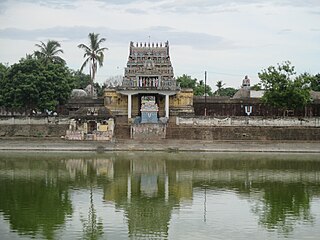
The Bhaktavatsala Perumal Temple is a temple dedicated to Hindu god Vishnu, located in Thirukannamangai, a village in Tiruvarur district in the South Indian state of Tamil Nadu. Constructed in Dravidian style of architecture, the temple is glorified in the Nalayira Divya Prabandham, the early medieval Tamil canon of the Alvar saints from the 6th–9th centuries CE. It is counted as one among the 108 Divya Desams dedicated to Vishnu. Vishnu is worshipped as Bhaktavatsala Perumal and his consort Lakshmi as Kannamangai Nayagi.

Ulagalantha Perumal Temple or Trivikrama Temple is a Hindu temple dedicated to Vishnu located in Tirukkoyilur, Tamil Nadu, India. Constructed in the Dravidian style of architecture, the temple is glorified in the Naalayira Divya Prabandham, the early medieval Tamil canon of the Alvar saints from the 6th–9th centuries CE. It is one of the 108 Divya Desams dedicated to Vishnu, who is worshipped as Ulagalantha Perumal and his consort Lakshmi as Poongothai. The temple is believed to have been built by the Medieval Cholas, with later contributions from Vijayanagara kings and Madurai Nayaks. The temple covers an area of 5 acres (20,000 m2) and has a temple tower that is the third tallest in Tamil Nadu, measuring 192 ft (59 m) in height.

Thanjai Mamani Koil is a set of three adjacent Hindu temples dedicated to Vishnu located in Thanjavur, Tamil Nadu, India. It is one of the Divya Desams, the 108 temples of Vishnu revered by the 12 poet saints called the Alvars. Unlike other Divya Desams where a single shrine is referenced, this set of temples is referred together in all the pasurams.
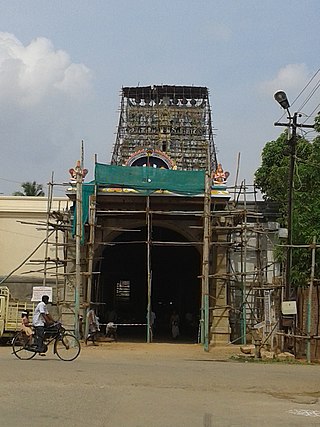
The Vanamamalai Perumal Temple, also known as Arulmigu Sree Vanamamalai Totatri Perumal Temple is a Hindu temple dedicated to the god Vishnu, in Vanamamalai or Totadrikshetram (Nanguneri), Tamil Nadu, India on the banks of Thamiraparani river. Constructed in the Dravidian style of architecture, the temple is glorified in the Nalayira Divya Prabandham, the early medieval Tamil canon of the Alvar saints from the 6th–9th centuries CE. It is one of the 108 Divya Desams shrines dedicated to Vishnu. Vishnu is worshipped here as Vanamalai Perumal and his consort Lakshmi as Varamanagi. The temple is believed to have been built by the Pandyas, with later contributions from Vijayanagara kings and Madurai Nayaks. The temple covers an area of 5 acres (20,000 m2) and has a five-tiered temple tower.

The Bhu Varaha Swamy temple is a Hindu temple, located at Srimushnam, in the South Indian state of Tamil Nadu. Constructed in the South Indian style of architecture, the temple is dedicated to Varaha, the boar-avatar of the god Vishnu and his consort Lakshmi as Ambujavalli Thayar. It is Classified one among the 108 Abhimana Kshethram of Vaishnavate tradition.
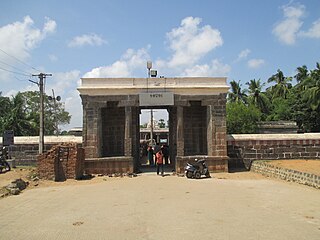
Nithyakalayana Perumal temple in Thiruvidandai, a village in Chennai, Chengalpattu district of the South Indian state of Tamil Nadu, is dedicated to Varaha, the boar avatar of the Hindu god Vishnu. Constructed in the Tamil style of architecture, the temple is glorified in the Naalayira Divya Prabandham, the early medieval Tamil canon of the Alvar saints from the 6th–9th centuries CE. It is one of the 108 Divya Desams dedicated to Vishnu, who is worshipped as Nithyakalayana Perumal (Varaha) and his consort Lakshmi as Komalavalli Thayar. The original structure of the temple was built by the Pallavas during the 7th century CE, with later additions from the Cholas during the 11th century.

Narthana Vallabeswarar Temple is a Hindu temple dedicated to the deity Shiva, located in Thirukoodalaiyathoor, a village in Cuddalore district in the South Indian state of Tamil Nadu. Shiva is worshipped as Narthana Vallabeswarar, and is represented by the lingam. His consort Parvati is depicted as Gnanasakthi and Parasakthi. The presiding deity is revered in the 7th century Tamil Saiva canonical work, the Tevaram, written by Tamil saint poets known as the Nayanars and classified as Paadal Petra Sthalam.
